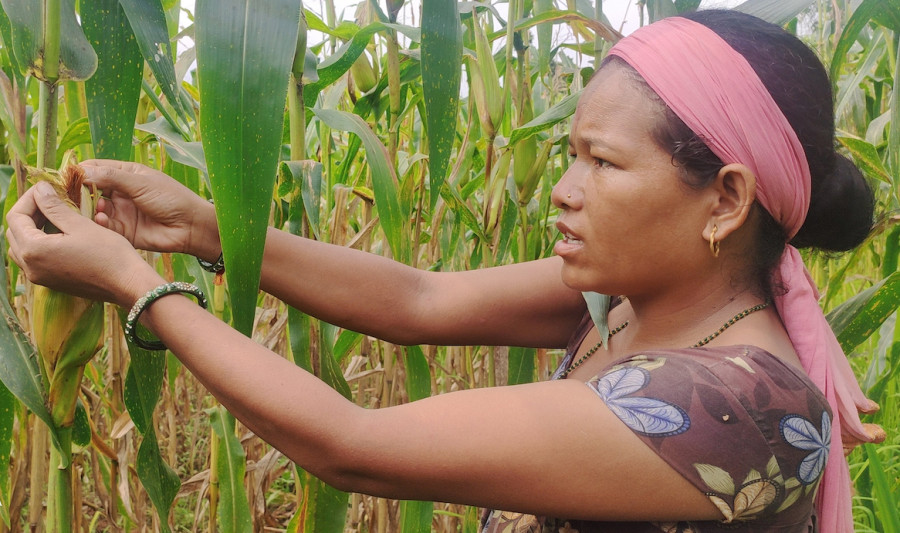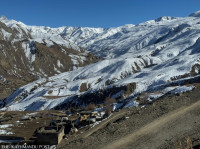Karnali Province
Surkhet farmers want compensation for locust devastation
Maize planted in around 3,500 ropanis of land was destroyed in locust attacks in June and July but authorities are yet to come forward to help farmers survive the ordeal.
Kalendra Sejuwal
When Mankali Sunar first heard reports that locust swarms were making their way into Nepal after eating their way through vast tracts of farmland in India, she hadn’t imagined the insects would reach her fields.
It was mid-June and just about two months ago, Mankali had finished planting maize in two ropanis of land in her village of Ramghat in Surkhet district.
But on the third week of July, a cloud of locusts invaded her farming village and devoured the crops.
"The maize had just about begun to sprout. The locusts destroyed them all. We cut the plants down to the stalks and fed them to the animals,” said Mankali. “With no harvest this season, it’s going to be difficult for us to survive.”
In case of a good harvest, the maize crop would have fed Mankali and her family of six for about two months.
The locust attack this year has left many farmers like Mankali in Ramghat, Sitapur, Kareli, Belchaur and Rampur villages in Bheriganga Municipality Ward 13 at a loss. The locust swarm that entered the area from India on July 18 and 19 has reduced the farmers to look at alternatives to put food on their tables.
The affected farmers had anticipated support from the authorities to help them tide over, but no help has arrived so far.
A few days after the locust invasion, a technical team led by Chitra Bahadur Rokaya, chief of Directorate Of Agriculture Development in Karnali Province, had reached Ramghat to assess the situation and to engage with farmers to find possible ways to minimise the damage.
A couple of days later, Minister for Land Management, Agriculture and Cooperatives Bimala KC had also reached Ramghat and met with the farmers. None of the visits made by government officials has borne any benefits to the farmers.
According to the municipal ward office, maize crops planted in around 3,500 ropanis of land belonging to 563 families were destroyed by locusts.
Tikaram Subedi, ward chairman, said an assessment conducted by a local development organisation had concluded that 1,982 quintals of maize crops were destroyed due to locust invasion in Ward 13 of the municipality.
"Maize is a staple crop for the locals in this area. Most of them grow their own maize for consumption but this year most granaries are empty,” said Subedi. “We are planning to submit the damage report to the municipality and the provincial government. But we don’t yet know if there will be compensation for the farmers, since none of the government authorities has come forward with a proposal."
The farmlands in Ward 13 do not have irrigation facilities. The farmers rely on rainwater to grow their crops. The lack of alternate sources of water for their fields leave them with very little choice of food crops they can grow.
“So most farmers only plant one type of crop, mainly maize, during the plantation season to see them through the year. But this year the farmers are left with nothing,” said Subedi.
Durga Bahadur Dangi, a farmer of Sitapur, suffered less damage compared to Mankali. His farm, spread over five ropanis of land, did not suffer complete annihilation. However, not a single plant in his field this year has a good kernel.
“The locusts devoured the tassels and ears of the plants leading to a bad harvest," said Dangi. "The locusts had covered the whole field. We tried our best to chase them away but failed. For two days, the insects devoured our crops and we could do nothing.”
According to Directorate Of Agriculture Development in Karnali Province, the locust attacks in June and July damaged around 40 percent of maize production in several districts of Karnali Province. Ramghat area of Bheriganga Municipality Ward 13 was the hardest hit area by locust invasion.
Rokaya, the chief at the directorate, said most farmers in Ward 13 will not have a good yield this year.
According to the data available at the ward office, the local farmers had planted maize in about 20,500 ropanis of land while paddy was planted in around 270 ropanis. Millet was also planted in a few ropanis of land.
Rokaya said the locusts did not damage the paddy much but destroyed the maize and millet equally.
Uma Malla of Belchaur had also planted maize and millet in 12 ropanis of land this summer. "We generally sell surplus maize and millet each year, but this year the locusts destroyed the crops,” she said.
The farmers have demanded compensation for their damaged crops.
"The local unit has to step in to facilitate talks between the provincial government and us in order to settle compensation amount,” said Dangi, the farmer from Sitapur.
Among the farmers, the ones with smaller plots of land are the ones in need of immediate compensation from the government.
Gopilal Sunar has a six-member family he has to provide for. He goes to India frequently to look for work because farming alone cannot feed his family.
But this year, he could not go to India because of the coronavirus pandemic.
"The locusts destroyed the crops and the coronavirus pandemic has shut down my prospect of going to India to work,” said Gopilal. “Nobody has come to our aid. Our situation is getting worse by the day and we have no one to turn to.”




 13.12°C Kathmandu
13.12°C Kathmandu










%20(1).jpg&w=300&height=200)

